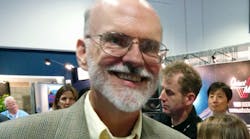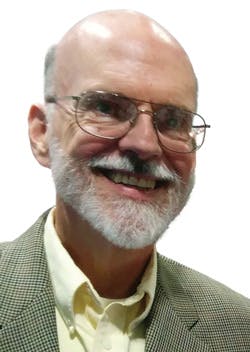JJD: What significant event most influenced your career?
SM: Probably the launch of the first Russian satellite, Sputnik, in 1957. I was eight years old, living with my parents in Duesseldorf, Germany. Even from the opposite side of the Atlantic, we could sense the shock that went through American society, and we especially felt the Europeans’ angst. Much like Americans, Europeans perceived a “Communist threat,” and it was closer and less theoretical for them than for Americans.
At that time, American education had evolved into complacency and self-satisfied smugness. It wasn’t bad. It just wasn’t very good. After only two years in a European school, I was nearly a year ahead of my classmates when I returned to the U.S. Thanks to Sputnik, though, all that started to change. Math and science education received the boost it needed, and I was a direct beneficiary of that new emphasis. I couldn’t have been born at a better time. I wonder how many people understand that the huge technological advances of the last 30 years or so are the direct result of the investment in science education of the 1960s. Without that, we wouldn’t be where we are. Someone else would be, but not us.
This file type includes high resolution graphics and schematics when applicable.
JJD: If you could have worked with anyone in the field, alive or dead, who would it be and why?
SM: An obvious choice would be Edwin Armstrong, the inventor of not just the superheterodyne receiver but arguably of modern radio technology. When I read his papers, I get the feeling that I think much like he did. Another of my heroes has always been Benjamin Franklin: a genuine Renaissance man and radical thinker with a penchant for wise, dry humor. Beyond that, many people I admire are from very different fields: the Philadelphia artist Thomas Eakins, who knew exactly what needed to be done and didn’t let the people who set the styles dissuade him; Jacob Bronowski; Bertrand Russell... I could go on, but I guess that’s a decent sampling.
JJD: What factors led you to focus on nonlinear circuits?
SM: I had developed an interest in low-noise mixers, primarily from working in radio astronomy in the 1970s. In those days, mixers were a hot research topic. Of course, in dealing with mixers, you come face to face with nonlinearity. There’s no way to avoid it. By the 1980s, microwave FETs were good enough that low-noise mixers weren’t needed below about 15 GHz. But putting substantial, low-noise gain ahead of a mixer exacerbated distortion. As FETs got better, they got smaller and distortion got worse.
In spite of this, academic research in the ’80s remained focused on low noise. But in industry, distortion was the greater problem, and no one seemed to be addressing it. It sounded new and interesting to me, and I had a bit of a head start from the mixer work, so I began working on it. The Nonlinear Microwave Circuits book was one result. It helped me organize my thinking, figure out things I didn’t know, and put the field into a coherent form.
JJD: How did you come to write your first book, and what was most rewarding about the experience?
SM: I returned to graduate school to finish my PhD after several years in industry. By then, I had acquired a wife, a kid, and a mortgage, so I couldn’t afford to stop working and become a full-time student. I worked all day and studied all night. Then, when it was over, I was completely at loose ends. I didn’t know what to do with myself. I needed some kind of project. I discovered that Artech House was open to new proposals, so I put together a proposal for the mixer book. Despite the fact that mixer theory had been a hot research topic for the previous decade, no one had written a comprehensive book on the subject. So there was a clear opportunity. Perhaps for that reason, Artech was willing to take a chance with someone they had never heard of, and they accepted the proposal.
Your readers might be amused to hear that I wrote the mixer book and, to a large degree, the later ones so that I could use them as a reference myself. I don’t have all that information at the top of my head, so I often have to refresh my memory. It’s nice to have a book that explains things the way I understand them. The process of writing a book also required getting my thoughts in order and filling gaps in my knowledge. It’s a nice way to develop a deeper understanding of a subject.
I was completely unprepared for what happened when the book hit the streets. Suddenly, I was “the guy who wrote the mixer book,” and lots of people knew who I was. I received quite a few unsolicited offers to consult, job offers, and so on. As a person who is generally pretty reserved, I found it all a little scary.
JJD: Would you say that many engineers avoid “hard” problems like nonlinearity? Is this hurting development in the field, and, if so, what could be done about it?
SM: I don’t think that’s really a problem. Many technologies have a high intellectual cost of entrance—for example, electromagnetics and solid-state device physics, as well as nonlinear circuit theory. In spite of their difficulty, there’s no shortage of people entering those fields. It is important, however, that we develop the tools that make those fields accessible to everyone who needs to deal with them. We also must make sure that they understand the fundamentals necessary to use them.
In my case, that means developing circuit-analysis software. Using that software effectively does not require knowing nonlinear circuit theory in detail. But it does require knowing a few things about termination criteria, number of harmonics, preventing ill-conditioning, and perhaps a few more things. Same story with electromagnetic simulators: You need to know some basic electromagnetics and some facts about the way the simulators work and their limitations. But you don’t need to understand the details of what’s going on underneath.
JJD: Who was your greatest mentor and why?
SM: It’s hard to pick out a single individual. Many people have helped me find the right direction. Some forced me to learn how to write effectively, to plan a project instead of just worrying about the problem of the day, and to realize that I could do a lot more than I thought I could. If you think about it a bit, that’s as it should be. We all learn many things from many people, not just one.
JJD: What would you recommend to young engineers after all of the experiences in your career?
SM: One: Stay technical. It’s more fun, and if you’re really good technically, you’ll always have a job.
Two: Develop your communication skills. This is every bit as important as technical skills.
Three: Don’t worry about money, glory, status, career, or any of that peripheral stuff. Stick to the knitting, and you’ll be surprised how those things take care of themselves.
Four: Develop a sense of history. Technologies evolve as much for historical reasons as technical ones. An understanding of history will show you, among other things, which technologies have a future and which are likely to be dead ends.
Five: Read, listen to good music, and appreciate the arts. This tells you a lot about how humans think and create. It’s not as far from technology as you might imagine.
JJD: What technological innovation had the most impact in the field during your career? How did it change things for you?
SM: The computer—and especially the small, powerful desktop computer. I didn’t do much with computers until mini-computers became common around 1980, but they rapidly became a big part of my life. I probably don’t have to explain why. But I should note that virtually all circuit design these days, linear or nonlinear, involves numerical analysis. The ability to have easy, quick access to circuit analysis and other kinds of computation has changed all of our lives. Without it, we’d still be, technologically, in 1963.
JJD: What was the greatest challenge you faced in your career?
SM: Probably the fact that I’m really not all that smart. I was never one of those guys who seem to waltz through school effortlessly. I always harbored a boundless jealousy for the people who did. It took me a long time to understand things, and I was continually struggling to keep up and keep my head above water.
Eventually, though, I realized that it was an advantage, as I had to learn how to dig into a subject and explain it to myself, get the subtleties, and avoid conventional wisdom. I’m still not so quick on the uptake sometimes. But when I finally figure something out, I usually know it in good depth.
JJD: Where do you see the field going in the next five, 10, or 20 years?
SM: I’m extraordinarily bad at predictions like this, as I tend to underestimate what’s possible. Everyone else, however, is just about as bad, so perhaps it doesn’t matter much. Twenty years ago, who would have predicted millimeter-wave CMOS? It would have sounded like a joke, like a waveguide-to-clip-lead transition or a diesel-powered necktie. The only thing we can be sure of is that the future evolution of technology will follow a path that is very different from what we imagine today.


